iModeler Review: The terrible, no good, awful, fatally-flawed Eduard 1/48 Bf-109G-6 (not!)
Gerhard “Gerd” Barkhorn joined the Luftwaffe in 1937 and completed his pilot training in 1939. Flying combat with JG 52 through the Battle of France and the Battle of Britain in 1940, he remained scorelewss though he was shot down in the English Channel on October 29, 1940. He scored his first victory - a DB-3 bomber- on July 2, 1941, following the invasion of the Soviet Union. His score rose steadily thereafter.
With 10 victories by November 1941, he was promoted to Oberleutnant. On May 21, 1942 he was appointed Staffelkapitän of 4./JG 52. His career continued steadily but unspectacularly until when he became "ace in one day" on July 21, by shooting down six aircraft.
By the time he was wounded on July 25 he had scored 30 victories since July 1. He was awarded the Knight's Cross on August 23 with a score of 59. Put out of action for two months, he returned to combat that October, and by Decemb er 1 had raised his score to 101. With 105 victories by January 11, 1943, he was awarded the Oak Leaves to his Knight's Cross.
Promoted to Hauptmann in August 1943, Barkhorn was appointed Gruppenkommandeur of II./JG 52 on September 1. On September 5, he shot down and killed Hero of the Soviet Union, fighter ace Nikolay Klepikov. In the same fight, II/JG 52's 173-kill ace Oberleutnant Heinz Schmidt was lost as Barkhorn scored his 165th and 166th victories. He reached 200 victories on November 30, 1943. At the time, II/JG 52 was the main German fighter unit covering the Crimea and Kuban. In the three months between December 1943 and 13 February 1944, the unit claimed 350 victories, of which 50 were claimed by Barkhorn personally.
On February 13, 1944 he reached 250 victories, and a price was put on his head by the Soviets. He had claimed 15 victories in September, 23 in November and 28 in December, including seven on December 28, 1943. He was awarded the Swords in March 1944.
He had scored 273 victories by May 31, 1944, when he was shot down by Soviet P-39 Airacobras on his sixth mission of the day. His Bf 109G-6 was severely damaged; despite severe wounds to his right shoulder and leg he managed to crash-land behind his own lines, but was hospitalized for four months.
Barkhorn returned to II/JG 52 that fall, but the psychological damage and combat stress on him was apparent; sitting in his cockpit he became overcome with anxiety, and felt intense fear in the air even when flying with friendly aircraft. It took several weeks for him to overcome this, but he returned to combat in October and claimed his 275th victory on November 14. He added another 26 kills over the next seven weeks and scored his 301st and final victory on January 5, 1945.
On January 16, 1945, Barkhorn was assigned as Geschwaderkommodore of JG 6, equipped with the Focke-Wulf Fw 190D. JG 6 consisted mostly of new recruits and former Bf-110 pilots, and suffered heavy losses against the American. After a month, Barkhorn was forced to take a medical absence because of severe physical and mental strain.
In April 1945, Barkhorn was invited by Adolf Galland to join the elite JV 44 flying the Me-262 jet-fighter. He found flying the jet difficult. On April 21, 1945, he flew his 1,104th and last mission. An engine flamed out as he approached an enemy bomber formation and he was forced to make an emergency landing. As he approached Munchen-Rheim airfield, he was attacked by P-51 fighters, He managed land the burning plane though he received a slight wound when the cockpit canopy slammed down on his neck as he attempted to climb out. He was taken prisoner by the Western Allies in hospital and was released from captivity in September 1945.
Gerd Barkhorn claimed 301 victories in 1,104 operational sorties. His total included 110 Yak fighters, 87 Lavochkin fighters, 21 Il-2s and 12 twin-engined medium bombers. He was shot down 9 times, bailed out once and was wounded 3 times.
The kit
There has seldom been as much outcry as there has been with the release of this kit be Eduard in the past month. Modelers have claimed it is "proportionally over-scale," with the scale listed as anything from 1/47 to 1/46, and it has been pronounced both unbuildable and the source of pain that will never diminish in the ranks of the faithful.
As is usual with modeler's Brew-Ha-Ha's (an argument fueled largely by alcohol and the anonymity of the internet, provoking words later regretted, and the subject of laughter and derision by anyone not in it), the reality is somewhat different.
The accuracy issue
Rather than get involved in the question of whose blue prints and drawings and measurements were more accurate, I decided to examing the kit as a model. This is what I found:
When comparing the allegedly-oversize fuselage with a Hasegawa 109G, there are interesting results. Measuring from the rear, the fuselages from the rudder hinge line to the wing trailing edge, are the same. length. However, the Eduard cockpit is 4mm forward of the Hasegawa kit, and the nose is 4mm longer. However, if you measure the fuselages lined up wing root to wing root, with the wing leading edges exactly matched, the nose length from the wing leading edge to the front end is the same for both kits, and the extra length appears in the rear fuselage, from the frame just forward of the radio compartment, to the rudder post. The fuselage is apparently correct when placed on the drawings in Lynn Ritger's definitive book on modeling the Bf-109, where the drawings are stated to be 1/48.
Both fuselages are the same width, and the canopies are interchangeable dimensionally.
The wing of the Eduard kit is 2mm different in chord and 6mm different in span from the Hasegawa kit, which is considered accurate. If you compare the upper Hasegawa wing part to the upper Eduard wing part, they are an exact match out to the inner edge of the leading edge slats. The extra length is at the outer end of the wing.
The vertical fin, rudder, horizontal stabilizer and elevator of the Eduard kit is interchangeable with the Hasegawa kit, as are the propellers and landing gear.
Verdict: the kit is NOT "overscale". It differs in two important measurements from the Hasegawa kit. However, the Hasegawa kit is known to be short in fuselage length. The Eduard wing is considerably greater in span.
In building the kit, I cut off 2mm from each wing, then butt-joined the wingtip. I also modified the leading edge slat and the aileron to fit this new span. When assembled, the model appears properly proportional, when compared with photographs.
Construction
Past that, the kit is easy to build. I had mine assembled in less than a day, beginning the work at 9am on a Saturday and finishing at 4pm.
The cockpit is more detailed than a Hasegawa kit, but less detailed than a resin set. Once built, you really can't see all that much unless you're wielding a penlight.
I had decided to do an Erla-built Bf-109G-6, with the different right side "beule bump." Interestingly, Eduard does not provide this part, though they offer an Erla 109 as one of their marking options. The Hasegawa part is a "drop fit" modification, presenting no difficulty.
The control surfaces are posable. I dropped the flaps and positioned the elevators full up, with the seat belt wrapped around the control stick, something that was frequently done with 109s on the Eastern Front, when gust locks were unavailable. I posed the rudder kicked to the side.
I used Xtracrylix paints for the model. I applied Gelbe 04, then masked it, then freehanded the RLM 76 lower color, the RLM 02, 71, 74 and 75 mottle, and the RLM 74 and 75 upper camouflage, duplicating the "jagged" Erla-style factory camouflage pattern.
I used the kit decals for the fuselage and lower wing national insignia. I determined that the kit upper wing insignia and the swastika were a bit oversize, and replaced those with aftermarket decals. The kit decals were used for the stencils. I used the Aeromaster "Top Guns of the Luftwaffe" sheet to do the Bf-109G-6 flown by Barkhorn when he was Kommandeur of II/JG-52 between September 1943-May 1944.
A final word
When the model sits next to other Bf-109 models situated a few inches away, and is viewed from the 18-24 inches distance most people not using penlights look at 1/48 models from, the eye cannot tell any discrepancy in size between it and the others.
The sky has not fallen, the world has not come to an end. It's a plastic toy, folks.
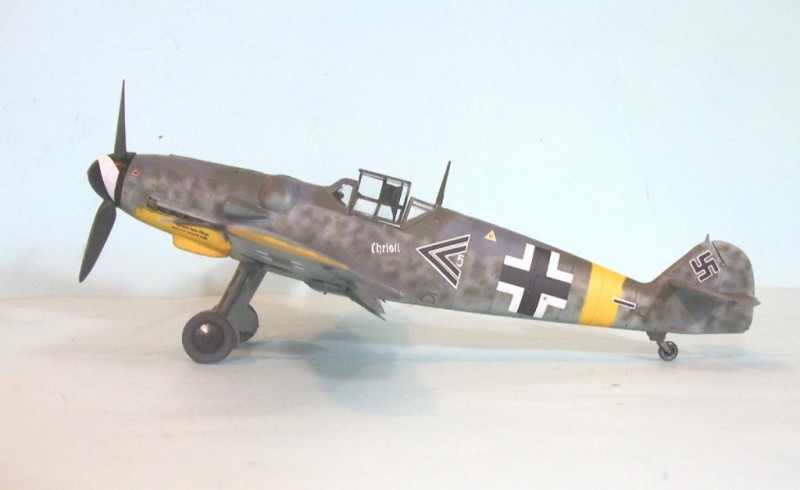
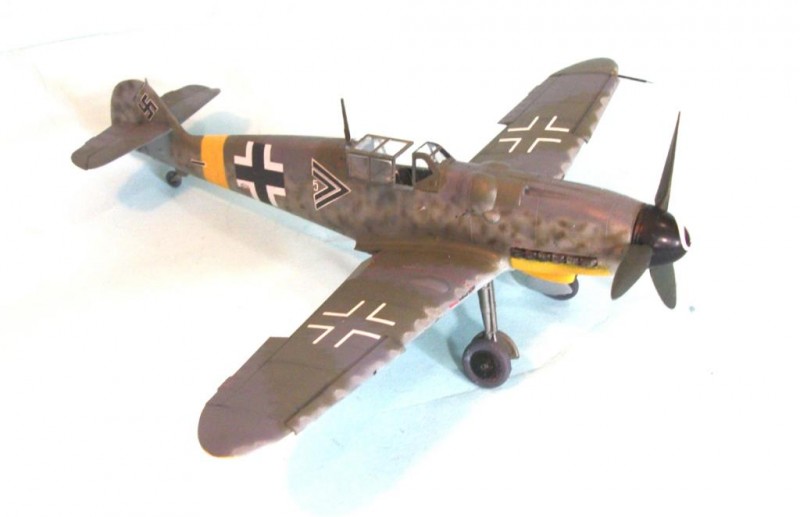
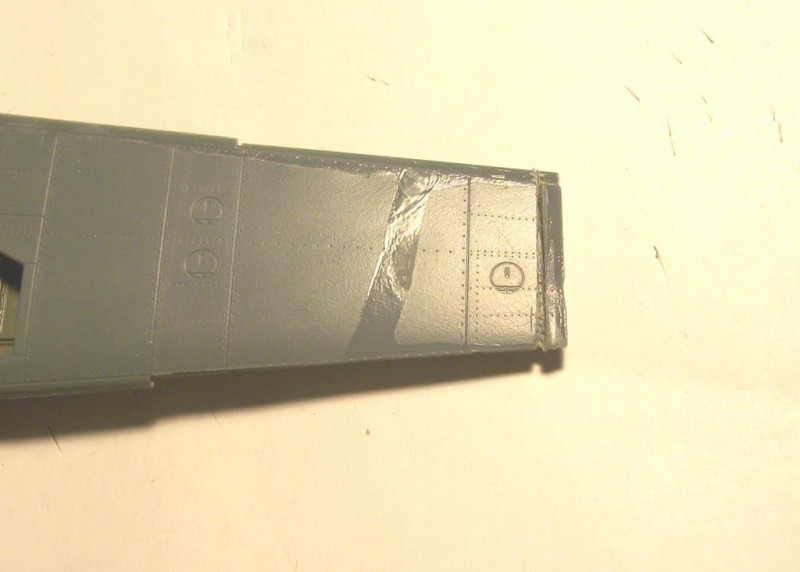
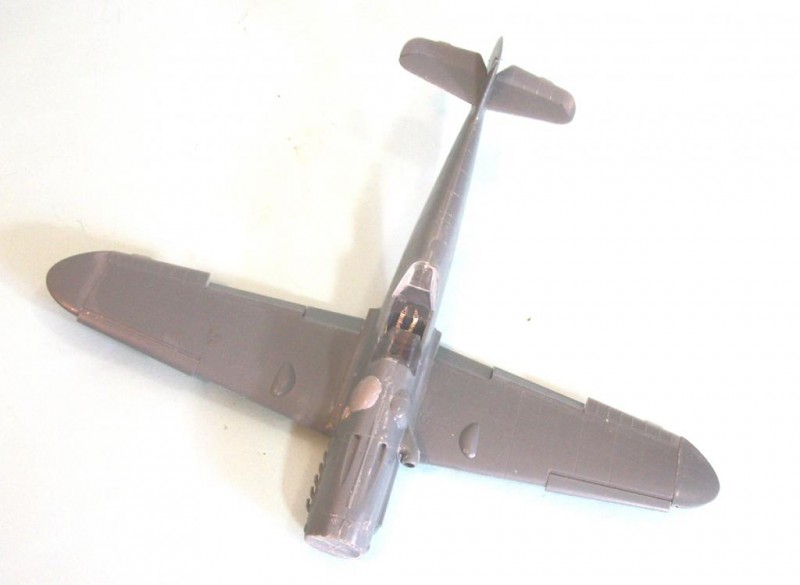
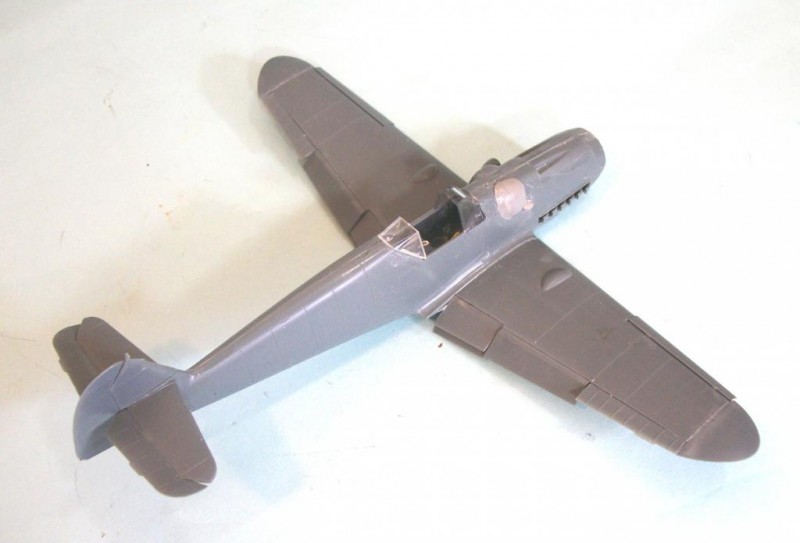
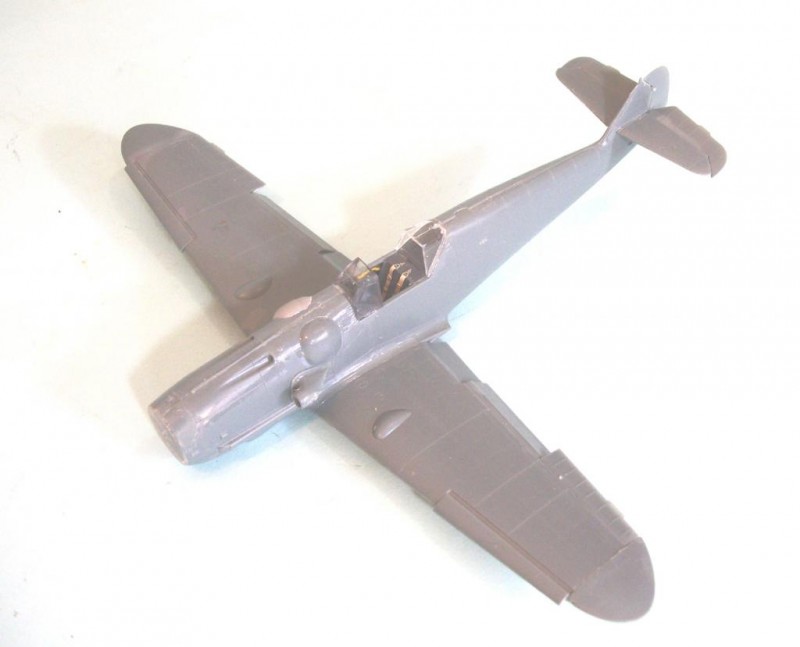
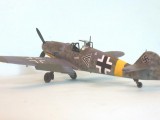
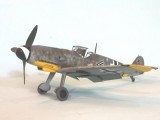
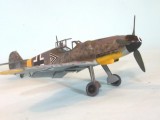
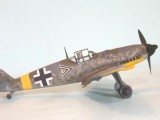
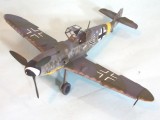
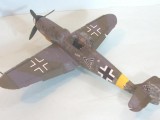
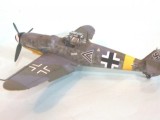
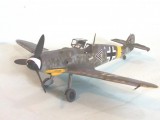
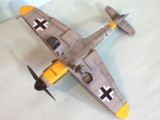
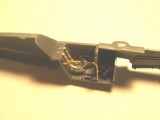
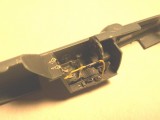
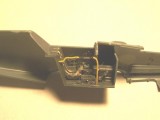
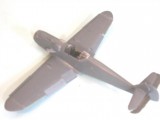
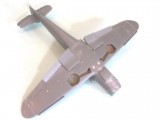
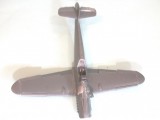

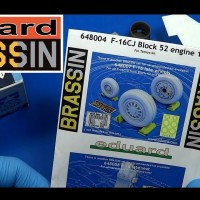
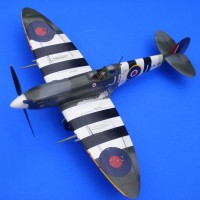

Gee, it's not the bloated horror we were led to believe. As someone on That Other Forum stated, some people talk, you build. Great job Tom!
Which forum is the one you´re talking about?
HyperFail.
Thanks for building it. It sounds like much of the angst over this kit is because the Hasegawa kit is short and it's been the standard for so long. Compound that with this kit's extra wingspan and I now see why some think it to be overscale. Anyways, yours looks good and I may purchase one since I haven't built a G-6 in about 25 years (Otaki).
My iPad didn't turn to dust when this 109 popped up so I guess life as we know it will continue.
Sharp, quick build as usual Tom.
From what I can tell, it looks like (although I can't be sure), a Bf-109-G6?
"Butt joined", Good Gawd man! Think of children.
Great article and a excellent build Tom.
I haven't seen comments from any other forums on the subject so I'm blissfully ignorant of all the hub bub! Looks like a good model to me. IF I get one it will be the weekend edition. Nice build Tom, thanks for the full and informative review.
After all the hubbub there's not much to be said, other than it's a nice build. Now build one without the surgery and see if anyone can tell the difference.
Nice job Tom, hopefully this will quiet all the nay sayers who won't even try to build the model themselves. It's a model, it's not perfect, no model is perfect.
That's a beautifully done model, congratulations!
If these kits are as terrible as I keep hearing, and anyone has one laying around that is embarrassing them and ruining their reputation or something, they can certainly send it to me 🙂
Looks like a Messerschmitt to me.
Good review of this kit and comparing it to the Hasegawa one. This one is much more detailed than any other 48th 109 on the market today; but, having said that it requires modeling skills to correct dimension error.
If I just started collecting and build 48th 109s, this one would be as good as any other to start with. But; since I already have a stash of Hasegawa kits and associated resins to enhance, I see no reason to buy this new flawed kit and make corrections. I'll just keep current flawed Hasegawa ones and correct, if inclined to do so,
Thanks for this review.
Bo
Even with 2 mms off each wingtip, it is still 6 inches too wide in span... A big improvement no doubt, but the fuselage/nose is still replete with errors.
If the cockpit is 14 mm wide, that is proportionately a larger error than the original wingspan error, and the same error is shared by the Hasegawa cockpit (should be 13 mm).
Fortunately, Zvezda has just announced an incoming Me-109G-6, so all this will soon be irrelevant. This seems to have been triggered by the Eduard kit's quality, so the Eduard release was indeed a very good thing in the end. G.
Sorry, just read that the Mansur Mustafin announcement was for a Vector resin G-6 conversion set for the Zvezda F-4, not a straight Zvezda G-6...
Still good new though... 🙂 G.
Wonder WHY resin guys just don't make a 4mm plug for the Hasegawa nose to make it better/best? From the drawing in Lynn's book, it needs to go ahead of the upper cowl cover.
Bo
Zvezda's G-6 is confirmed, which lead to the cancellation of the Vector set.
For the Hasegawa it would be more like four inches, so a 2 mm plug. Wouldn't change the undernourished lower nose, tall exhausts and generally hopeless case of a 25 year old kit 10% too broad...
that's beautiful
Well there goes any thought of round two with a Jerry Springer themed modeling debate on the forms. Sort of like listening to a whoopee cushion expel that last gasp of air when you know that Lynn Ritger's drawings are being used to compare the kits. It's the last nail in the coffin ...no one really pointed out the Hasegawa's shorting comings with regards to the fuselage length. That wasn't expanded upon and was conveniently set a side.
So we now can say that Pro-wrestling, reality TV and some modeling forms can be Bad theater and scripted too.
Nice model, great article and effort Tom. Good timing too.
Great article! Sadly, it is still being debated over on HS, and after a link to this great article with some mild character assassination of Tom, following. And honestly I think Tom's article is the best most even handed review I have heard. And it will be cold day in Hell when I buy the Zvezda kit because I honestly think they started the flame war. Ok...I'm done,
HyperFlail, never missing a chance to miss a chance...
It is sooooo embarrassing, that I share my favorite activity other than writing, with those drooling morons. (none here, thank goodness!)
As per your usual, Tom, a great, well-written, informative review.
I am still just amazed at the vitriol over the whole business. And I still hold there is something rotten in Denmark (no offense to our Danish friends) about the whole thing. I must admit though Eduard did not help themselves with their hype before hand, but really, they are successful, they offer good value for the dollar and if you take your time and exercise some modeling skills almost always you will get a nice result!
Now that the dust is beginning to settle...the publicity or the buzz being generated about this kit is the best free advertizing that Eduard could possibly hope for. Any news these days be it good or bad is considered good news . I'm sure Eduard would rather steer the conversation rather than go along for the ride. However, they are still in great position to show the goods and spot light all the positives about this kit. A half full glass is the best approach in life and is a good approach to enjoy modeling to too.In this case the positives of the kit out way the negatives and Toms positives approach ...like "Builder Bob's " motto of " Can he do it? Yes he can." is what modeling is all about.
Interestingly enough, I need to take back the comment about HyperFlail. Contacted the posters on that thread, pointing out that the only people who ever get 109 gear "right" are those of us who have done 1/32 Hasegawa 109s where the molding is such that the gear is moron-proof, and they've all commented that whether or not one likes the kit, I have shown the truth about it. That's about as good an apology as is going to come from there, and I will take it.
The best, of course, is that Brett Green is doing his own build of the kit, following my lead.
I just got hold of the Zvezda Bf-109F-4, which really is really accurate (though fiddly as all get back), and it really is the truth that Eduard managed to severely "screweth the poocheth" Even though in the end it does look OK.
I actually feel sorry for Eduard. They got the Spitfire "dead on" and as a result they will be able to "print money" with every Spitfire sub-variant they ever do. They could have had the same here with another week's research. It's like I learned in the movie business: many good screenplays get turned into bad movies, but no good movie was ever made from a bad screenplay.
i don't know tom...take a movie like the professionals...no Pulitzer prize winning script...but you pack it full of charismatic actors trying to out act each other and you have a classic western...or the magnificent 7 or the dirty dozen for that matter...things are so over written today they are over my head
Take it from me (you're talking about my previous business), nowadays they aren't written.
I will differ with you about the movies you mentioned. Those are good scripts (read them all) - the characters are there as they come across on-screen, the dialogue, the action, the suspense. Many a bad movie was made from a good script, but no good movie was ever made from a bad one. As one well known actor I knew said, "I'm only as good as the material is."
yeah but they are all ways fighting for land or water rights...or turf...a women...it takes James arness or Richard boone to pull it off...mitchum used to call himself howard hughes horse sh poop salesman and everybody has one...they aren't all in the heat of the night or even pink panther...and boring actors like cooper put me to sleep no matter what you write
Your photos say it all: proportion seems fine to me, paint looks great too, so it's a Bf 109G6 as far as I'm concerned & a very nice one too!.
My attitude is that if I want a model badly enough I'll do my best to fix it to my satisfaction if it's not perfect OOB. It's always nice to get some good comments about my work from fellow modellers, but when it's all said & done, I'm the one I have to please.
I would be delighted if Eduard chose to give me their '109G.. On the other hand I have four Hasegawa '109s in my stash which have certainly not suddenly become redundant!
it's really an horrible Dewoitine...oups ! it's just an edauard's 109...
(JOKE)
Really good model...congratulation !
A terrific and flame-free review, TC. Thanks for your straight-up assessment of the kit. I'll eventually get one and, from the sounds of it, enjoy the build!
Hi to all, i'm new in iModeler, in fact i came here looking for a review of Eduard's 109, i'm returning to the hobby afther 18 years and i for sure will buy this model, why? I have a crush for the 109, i just finished a Tamiya 109e i'm building a Fujimi and Monogram 109g, i like to build not to mesure.
Good review.
Welcome back, it's like riding a bicycle 🙂
Plus now you have the hand-eye coordination you didn't, so you can learn from everyone else 10 times faster than you think you can.
Yeah to me the irony is, real aircraft will also often differ slightly, as any RAF QFI who knows the Shorts built Tocano will tell you. They sure told me). I swear that Spitfire MkIX's two of which I have had the good fortune to have been able to look at closely, both had subtle but as far as I could see, slightly different shapes to their top engine cowlings. From the cockpit, the one definitely had a cowling that flattened out near the spinner, the other ones cowling looked rounder, in that area. The cowling is one shaped piece of metal sheet basically, so it is understandable you may get slight differences. Yes fair enough, you won't get the same difference scale wise, as you may get on a model, but the point is, if it looks right, a model is OK with me. It is after all a MODEL of...the real thing.
As a matter of fact, the Spitfire IX/XVI does have a different upper cowling between early and late production aircraft, with the later cowl (the one with the bulge) designed to allow use of the slightly-different Packard-Merlin engine. That cowling was standardized across both production lines (IX and XVI) regardless of which version of Merlin went inside. Eduard makes provision for that with separate cowlings in their kit, which is an example of the lengths they went to to "get it right."
Hitler has a few things to say about the Eduard 109. Swallow all liquids before clicking. 🙂
http://www.britmodeller.com/forums/index.php?/topic/234961712-fuhrerous-about-eduards-bf-109g/
Tom, very interesting about the Spitfire cowlings, reference my previous comments, the one Spitfire was a low back bubble top, a MkXVI but technically was in fact, a rare low back MkIX, as it had a factory fitted Merlin 70 (as I recall), not the Packard Merlin. But you are absolutely right, the low back's cowling was flatter and squared off toward the spinner, whereas the other aircraft, a standard MkIX, had a rounder profile of the top cowling in that area. I thought it was a quirk of the re-build the aircraft went through! Very impressed Eduard actually allowed for this, I will have to get one of their 1/48 Spitfire kits. Did Tamiya get this difference with their 1/32 masterpieces, I wonder? It isn't somthing I thought, that would be all that noticeable to all but some Spitfire experts! Also, years ago I built the Otaki 109G, a nice kit, which had Barkhorns markings on what was a very comprehensive decal sheet. He was an interesting character, as despite being the second highest scoring ace in air combat history, seems to be largely forgotten, sadly.
Tamiya got it right also asregards the upper cowling.
Those markings for Barkhorn in the Otaki kit used to drive me nuts, since they are chevron-triangle-5, not double-chevron-5 as here. When I was researching this one, I discovered both markings are right, this being for the airplane he flew September '43-May '44, with the chevron-triangle-5 markings on the one he flew July '44 - January '45. There's always a simple explanation to everything when you find it.
Tom, you had me right up until you called it a toy! 😉
Nice work as usual, sensible review, I will definitely be getting one or two of these.
As of February 2015, it looks like the Eduard full complete retool of this kit is well under way...
Every sprue is redone, all major parts and most minor parts as well, so it looks like hardly anything of the original kit will remain...
I'm pretty sure this is a first in the history of mainstream injection model making... Sure is an expensive way to get a model right...
Gaston
Great write up. I find the righteous flogging of every new kit's fidelity exhausting and it's the one of the main reasons I drifted away from the HS forums. I don't have an Eduard 109 (yet), as I've got more than a dozen other 109's waiting in the stash, but based on your review I wouldn't hesitate to pick one up. Your seatbelt thing reminds me of how my dad would lace the lap belt of our Cessna through the yoke when we tied down.